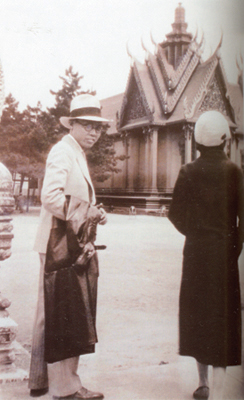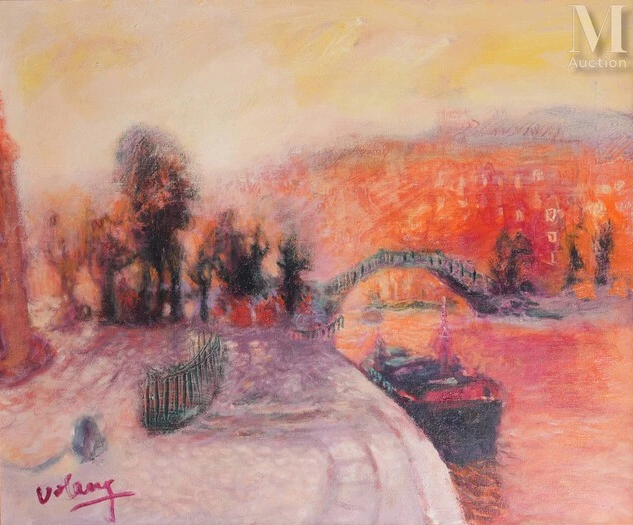On June 18, 2024, Millon will auction a single work in SO UNIQUE ! – The work Mother and child, made of silk, created around 1935-1945, dimensions 62.5 × 46 cm by Lê Phổ (1907-2001).
To organize an auction of only one painting, Millon has highly appreciated the artistic value and commercial value of this excellent, beautiful work.

LÊ PHỔ (1907-2001)
Mother and child, circa 1935-1945. Ink and color on silk
Signed and stamped upper right, glass frame, 62.5 × 46 cm
Provenance: Private collection, France
Estimate: 200,000 – 300,000 EUR
To prepare for the auction, Millon discussed with Viet Art View on a number of contents expressed in article, art video… to highlight the special beauty of the work Mother and child.
With Mother and child, we place the work in a special, representative position, throughout Lê Phổ’s career on the theme of motherhood. Hopefully, this work will be successfully auctioned, becoming a focal work in a quality collection.
This special auction is also the premise for the duplex auction of Vietnamese art in mid-September 2024. The auction will include works by famous Vietnamese artists.
Collectors and art lovers might like to follow and participate in the auction on June 18 with the work Mother and child by Lê Phổ at Millon.
***
Lê Phổ was born in 1907 in Hà Đông. His father was Lê Hoan – Viceroy of Tonkin. Feudal society at that time allowed men to have more than one wife. Therefore, like men with wealth and power, Lê Phổ’s father was no exception. His mother was his father’s youngest wife. He is one of three sons of his mother. Lê Phổ lost his mother at the age of three and his father also passed away when he was eight. Therefore, Lê Phổ’s childhood was not very happy.

Lê Phổ (1907-2001)
Because of the lack of parental love, for Lê Phổ, his beautiful years were when he studied at the Indochina Fine Arts College. Lê Phổ loved his teachers – Mr. Victor Tardieu and Joseph Inguimberty very much.
In 1931, Lê Phổ was chosen by Victor Tardieu to be an assistant at the Exhibition of Colonial Countries taking place in Paris. This is the first time young Lê Phổ had gone abroad. In 1932, he interned at the National College of Fine Arts, Paris. In 1933, Lê Phổ returned to Việt Nam, he taught as an apprentice at Indochina Fine Art College, at Protectorate High School and was loved by students.
In 1937, Lê Phổ became the Art Director in charge of the Indochina area of the International Exhibition held on Swan Island – an exhibition that his teacher, Professor Victor Tardieu, devoted a lot of attention to. Because here high quality artworks of the first generations of students studying at Indochina Fine Arts College were displayed.
In a letter dated June 2, 1937 written from Hà Nội, Victor Tardieu excitedly described in detail the installation design. 10 days after writing the above letter, Victor Tardieu suddenly passed away in Hà Nội. At that time, Lê Phổ was still in France. It might be possible that people who were close and beloved to him, his father, mother, and his teacher, all said goodbye made Lê Phổ decide to settle in France, considering this country his second homeland.

Lê Phổ (standing first on the left) with his two brothers
and their families, 1931, Sài Gòn.
A short time before his first trip to Paris.

Lê Phổ in 1931 at Angkor Wat Pavilion, the Exhibition
of Colonial Countries in Paris.
Lê Phổ painting
Basically, Lê Phổ’s painting belongs to romanticism, a harmony between Vietnamese culture, influenced by absorbing the quintessence of Eastern and Western culture, divided into three periods.
The first period was the time when Lê Phổ was in Hà Nội, and a few years later when he was in France. He fully experimented with lacquer, silk, and oil, basic painting style, classic, realistic, academic…
The second period is called the Romanet period. The painting style of this period was very profound, cultivated by the special friendship between Lê Phổ and Mr. André Romanet – the owner of Galerie Romanet. This continued for 23 years from 1941 to 1964.
Lê Phổ’s silk paintings during this period got many achievements. He created images of Vietnamese women with traditional costumes; Romantic, elegant, graceful style… decorative details are boldly Vietnamese, deeply inspired by images, customs and traditions of the homeland.
Lê Phổ’s third (the last) period began when he signed an exclusive contract with Wally Findlay Galleries of the United States in 1964. From this point on, he almost exclusively worked in oil.
The image of Vietnamese women and children is always present, but the style, manner and colors in the painting have strong influences of European Impressionism, Post-Impressionism, creating great attraction for Lê Phổ’s paintings.

Time of creation
Based on the visual details on the painting, based on a number of works with similar themes, characters, composition styles, signatures, and seals, it is possible that the work Mother and child was created between 1935-1945, Lê Phổ’s second period, before and after he settled in France since 1937.
This was the peak period of silk, and also the peak of artistic value throughout Lê Phổ’s career. This period was the intersection of cultural layers between East and West in his art. The works were created from the thoughts of a Vietnamese person who always directed his outlook on life towards his homeland. To explain this strong interference, we overturn a few landmarks.
In 1931, when he first set foot in Europe, he saw with his own eyes the works at the heights of classical academic art at museums in France, Italy, the Netherlands, Belgium… Lê Phổ was truly overwhelmed on the achievements of classical master painters. He was passionate about standard shapes, romantic classical style, and technical sophistication, ideas gradually formed in his head.
In 1934, Lê Phổ had the opportunity to live in Huế for a short time to complete some commisions from the Royal Court such as portraits of King Bảo Đại and Queen Nam Phương. Like Mai Trung Thứ, he was fascinated by the gentleness of Huế women, the architecture and landscape here. In the same year, he also had a trip to Beijing to learn about Chinese painting with thousands of years of tradition, feeling the essence of silk painting through classic works in museums.
Those experiences and the years of thoroughly absorbing the art education of the Indochina Fine Arts College (from 1925-1930) have formed a distinctive style called “painting of Lê Phổ”. With Vietnamese blood flowing through the veins, his passionate love for people, the scenery of his homeland, all of these things have blended in his works. In particular, works of silk from 1935-1945, with themes of young women, mothers and families have become the superlative symbols of Lê Phổ’s art.
Symbol of motherhood
Included in the theme of mother and child, the silk painting Mother and child displayed and auctioned by Millon on June 18, 2024 is one of the most excellent silk works on the theme of mother and child by Lê Phổ. This is based on objective assessments when we compared with his works of the same theme and time of creation.
All the details present in the work are reminiscent of the beloved image of a Vietnamese family, in the pre-1945 period. From the mother’s clothes such as áo dài (designed by Lê Phổ), brightly colored head scarves (often used by Huế women), to decorative details such as the porcelain vase with camellia, the table used for tea and writing. This type of table is of Chinese origin with a straight shape of legs, when imported to Việt Nam, it was shaped with four legs bent out. Indochina artists used lacquer, gilded lacquer to decorated with floral motifs, creating a new type of design that was very popular in urban families. On the floor is a multicolored flower carpet that is blurred to focus on the beauty of the two main characters.
Image of the two characters is reasonable and harmonious. The physical ratio between the mother and child is balanced, with a delicate and gentle appearance.
The baby boy is plump with jet black hair, chubby cheeks, his arms around his mother’s neck, his eyes looking up. The young mother sat, her arms gently opened, comforting, embracing her child in indescribable love.
The image of a healthy baby, in addition to being a symbol of health for the future with great responsibilities in the family, also contains the immense love a mother has given her child as a source of nutrition from body to soul. Love is the best source of nourishment for the soul, helping the child form a good personality.
The artist’s deliberate sophistication is clearly shown when describing the image of a young mother gently using her clothes to cover her child. This is the highlight, the difference between Eastern and Western culture. Just from a simple act of covering the child with the clothes, seemingly “unconscious” but in fact, formed from the traditional Asian ideology of shelter and protection that the mother has been taught through generations.
Other equally delicate details are skillfully expressed, such as the image of the scarf. This intention of the artist has made the painting complete with soft beauty, imbued with Vietnamese femininity. The thin, gentle scarf draped over the mother’s shoulders, loosely wrapped around her and the child, has just solved the problem of shaping and composition, completely expressed the love and care of a mother.
The special feature of the work Mother and child is the inner beauty of the work and also something we cannot see with eyes. The artist used neutral, warm and soft colors, very moderate. But it seems that warm and softness is not a feeling from color, it is a magical warm covers the space, coming from a mother’s love for her child.
Painting must express things that cannot be seen but must be felt by the mind. These are things that cannot be seen with the eyes but be seen with emotions. Lê Phổ perfectly used his talent at the highest level to express his thoughts.
Considering the overall work, from shaping to color and details, we assess that this is the superlative silk painting on the theme of mother and child in Lê Phổ’s career. This painting deserves to be an important focal point in a quality art collection.
There is a feeling of time standing still when looking at this beautiful work. The vast sky with beautiful nature, the warm house spreads tenderness and caress because in each of our minds there is an angel named Mother. The message of the work is full of emotions – A mother’s love is the source that nourishes the soul.
Written by fine arts critic Bùi Hoàng Anh
Art director of Viet Art View







